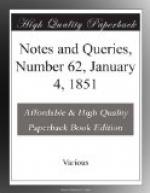The Histoire des Sevarambes is a fictitious account of a nation in the Southern Ocean, visited by a supposed navigator named Siden. It’s first appearance was as an English work, with this title:
“The History of the Sevarites or Sevarambi, a nation inhabiting part of the third continent, commonly called Terrae Australes Incognitae; with an account of their admirable government, religion, customs, and language. Written by one Captain Siden, a worthy person, who, together with many others, was cast upon those coasts, and lived many years in that country. London: printed for Henry Brome, at the Gun, at the west end of St. Paul’s Churchyard, 1675. 12mo. pp. 114.” No preface.
There is a second part, “more wonderful and delightful than the first,” published in 1679 (pp. 140.). The licence by Roger Lestrange bears date Feb. 25. 1678/9. There is a short preface, without signature, arguing that the country of the Sevarites is not fabulous.
A copy of the original edition of these two parts is in the British Museum.
Shortly after its publication in England, this work appeared in France with the following title:—
“Histoire des Sevarambes, peuples qui habitent une partie du troisieme continent ordinairement appelle Terre Australe, contenant un compte exact du gouvernement, des moeurs, de la religion et du langage de cette nation, jusques aujourd’hui inconnue aux peuples de l’Europe. Traduite de l’Anglois.” First Part, Paris, 1677. 2 vols. 12mo. Second Part, 1678-9. 3 vols. 12mo.
Both parts are dedicated to Monsieur Riquet, Baron de Bonrepos; and the dedications are both signed with the initials D.V.D.E.L.
The British Museum contains no French edition of this work earlier than an Amsterdam reprint of 1716. The above account of the early French edition is taken from the Dictionnaire Historique of Prosper Marchand (La Haye, 1758), tom. i. p. 11., art. ALLAIS. This article (which may be cited as a model of bibliographical research) attributes the authorship of the Histoire des Sevarambes, upon evidence, which, if not conclusive, is very strong, to Denis Vairasse, or Vayrasse. Marchand explains the initials appended to the dedications of the French edition to mean, Denis Vairasse d’Allais en Languedoc. He likewise considers Siden as the anagram of Denis; and Sevarias, the legislator of the Sevarambians, as the anagram of Vairasse. Some of the religious opinions expressed in this fiction were thought bold, and the authorship of the work was at one time much discussed: it was attributed both to Isaac Vossius and Leibnitz. It was translated into Dutch, German, and Italian; and there is an English edition, London, 1738, in 1 vol. 8vo., in which the preface from the French edition, alluding to Plato’s Republic, More’s Utopia, and Bacon’s New Atlantis, not to be found in the original English edition, is introduced. This volume is entitled—




